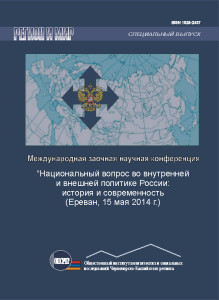Փոփոխությունները Հայաստանի նախնական և միջին մասնագիտական կրթության համակարգում 2005-2015 թթ.
ОБРАЗОВАНИЕ
Abstract
During the Soviet period the graduates of 86 preliminary schools and 69 vocational professional institutions in 127 specialities served in different spheres such as economy, education and culture. In the 1990’s the abrupt economic decline had its negative influence also on professional education. In 2001-2005 preliminary educational 104 institutions were liquidated, and their specialities were officially included in the curricula of senior classes of the schools of general education. However, in 2005 the sector was restored and in 2006 28 such institutions already existed. The under developed labors market, the high level of unemployment, the deeply-rooted stereotypes decreased the attractiveness of this sector. With the new requirements of the labor market the list of licensed specialities changed. In 2004 the Government of the Republic of Armenia adopted “The strategy of the preliminary and middle professional education and learning”, and in 2005 the RA law on “Preliminary and Middle Level Professional (Vocational) Education” was adopted. The concept on the development of the sector approved in 2008 was in compliance with the principles of the Copenhagen Declaration. Its aim was the integration to Europe and strengthening of mobility of the students. In 2009 the European Fund of Education (EFE) launched a new course called the Turin Process. Armenia has joined the Turin process since 2010 and the sector entered into a new stage of reforms. Global changes of the labor market changed the paradigm of education. The concept of lifelong learning, integration of education and labor market, emphasisying not only knowledge but also skills and professional competencies gained great significance. In the framework of the pilot programm 12 vocational proffessional institutions out of 110 were selected, which were to become multisectoral colleges and set an example for others. Within a few years theresources of the colleges were improved: new laboratories and computer classes were opened and the technical equipment enhanced. In 2008 the National Center for Professional Education and Learning was created. The center developed state standards for preliminary and vocational professional education and moduls, and trained the teaching staff. In the same year the National Center for Professional Education Quality Assurance was established. Shortly, the National Qualifications Framework (NFQ) and accreditation standards were developed and approved by the Government. Subsequently, the implementation of the ECTS is envisaged, conduct institutional and programm accreditiation, as well as increase the independence of educational institutions. The reforms in this sectorof education still continues.

